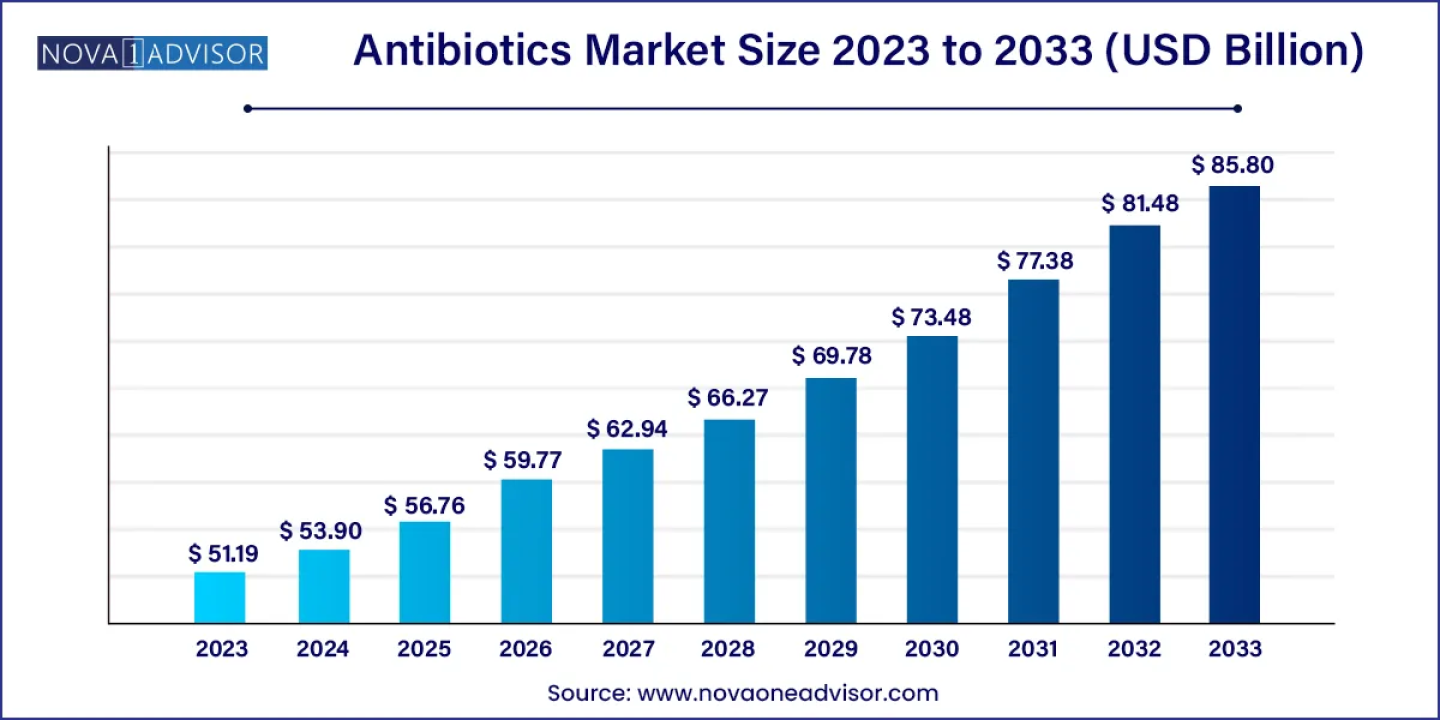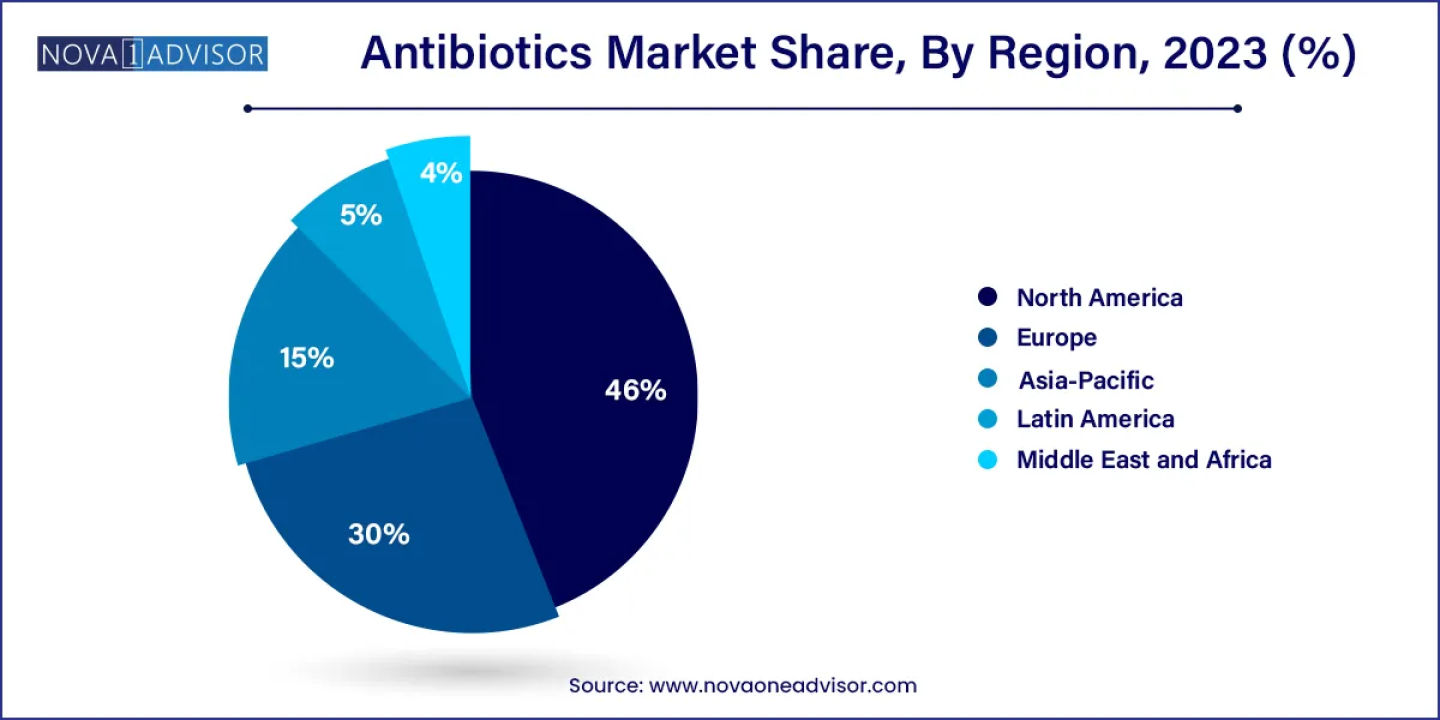According to the latest study, the global antibiotics market size is calculated at USD 53.90 billion for 2024 and is expected to reach around USD 85.80 billion by 2033, growing at a CAGR of 5.3% from 2024 to 2033, Asia Pacific accounted for the highest market share of over 46.00% in 2023.
Get Sample Copy of Report@ https://www.novaoneadvisor.com/report/sample/6972
The antibiotics market exhibits robust growth driven by various factors, including the diversity of available antibiotics and their efficacy against specific bacterial or parasitic infections. Antibiotics are categorized based on their mode of action, enabling targeted treatment for different types of infections such as meningitis or pneumonia, where antibiotics play a critical, life-saving role.
The antibiotics market is experiencing rapid growth driven by the increasing demand for medicines that combat bacterial infections in both human and veterinary healthcare settings. These medications function by either eradicating bacteria or inhibiting their proliferation, targeting specific bacterial infections such as strep throat, urinary tract infections, and E. coli. Primarily prescribed for serious bacterial infections, antibiotics are available in various forms including liquids, tablets, capsules, injections, creams, and lotions, catering to diverse patient needs. However, ensuring the judicious use of antibiotics is imperative to mitigate antibiotic resistance, a growing concern where bacteria develop resistance to these drugs over time, diminishing their effectiveness. Notably, antibiotics do not treat viral or fungal infections, underscoring the importance of accurate diagnosis and treatment selection.
Antibiotics Market Key Takeaways
Asia Pacific accounted for the highest market share of over 46.00% in 2023.
North America and Europe region held the market share of around 45.00% in 2023.
By drug class, penicillin hit highest market share of over 27% in 2023.
By action mechanism, cell wall synthesis inhibitors segment has garnered revenue share of 53% in 2023.
Immediate Delivery Available, Get Full Access@
https://www.novaoneadvisor.com/report/checkout/6972
Market Dynamics
Driver
Economic Growth and Antibiotic Consumption
The significant rise in global antibiotic use finds its roots in the steady increase in GDP, particularly evident in many developing countries. Economic prosperity has substantially enhanced the quality of life for individuals in low- and middle-income countries (LMICs), correlating positively with heightened antibiotic consumption rates. Key drivers behind this trend include improved access and affordability to antibiotics without prescription, as well as the utilization of leftover antibiotics from previous prescriptions.
Additionally, factors such as inadequate training during early clinical practice, irrational prescriptions influenced by pharmaceutical companies, and insufficient diagnostic processes further contribute to the proliferation of antibiotic usage. These drivers collectively fuel the growth of the antibiotics market, reflecting the complex interplay between economic development, healthcare practices, and pharmaceutical consumption patterns on a global scale.
Restraint
Challenges in Discovering and Developing New Antibiotics
The discovery and development of novel antibiotics pose significant challenges within the pharmaceutical industry. The rigorous scientific process, coupled with lengthy and expensive research and development phases, often results in high failure rates. It typically takes 10-15 years and requires investments exceeding $1 billion to bring a new antibiotic to market. Despite heavy investments, pharmaceutical companies struggle to recoup costs or generate profits due to limited market opportunities. Moreover, new antibiotics are reserved as a ‘last resort’ against dangerous bacteria, necessitating their sparing use to mitigate the development of resistance. Consequently, compared to more lucrative treatments, antibiotics tend to command lower prices, further constraining market growth. These factors collectively underscore the formidable barriers hindering the advancement of the antibiotics market and underscore the need for innovative solutions to address antimicrobial resistance while ensuring sustainable investment in antibiotic research and development.
Opportunity
Academic Research for Antibiotic Innovation
Academic research, particularly in academia, is spearheading innovative approaches to discover and develop new antibiotics to combat infectious diseases caused by resistant bacteria. A pivotal aspect of these efforts involves recognizing global microbial diversity as a rich source of potential anti-infectives, with untapped chemical potential awaiting exploration. Advancements in high-throughput sequencing techniques have made it cost-effective and efficient to sequence the genomes of individual cells, whether extracted from soil samples or skin swabs. Consequently, research groups worldwide are pioneering the development of new heterologous host strains to overexpress novel biosynthetic gene clusters (BGCs), thereby significantly enhancing the likelihood of discovering novel natural products with antibiotic properties. This concerted effort presents a promising opportunity to invigorate the antibiotics market, fostering the emergence of groundbreaking treatments to combat antibiotic-resistant infections and address critical healthcare challenges on a global scale.
Immediate Delivery Available | Buy This Premium Research
https://www.novaoneadvisor.com/report/checkout/6972
Report Highlights
By Drug Class Insights
Within the antibiotics market, the penicillin drug class has demonstrated remarkable growth, commanding the largest share due to its extensive sales and widespread availability. Derived from the Penicillium fungi, penicillins constitute a group of antibiotics renowned for their efficacy in combating bacterial infections. Notably, Penicillin V, a prominent member of this class, is utilized in treating a diverse array of bacterial infections including ear, throat, and skin infections, as well as in preventing rheumatic fever. The robust performance of penicillin-type drugs underscores their significance within the antibiotics market, reflecting both their therapeutic efficacy and widespread utilization across various healthcare sectors.
In addition to penicillins, the antibiotics market encompasses several other essential drug classes, including cephalosporins, tetracyclines, macrolides, sulfonamides, fluoroquinolones, and aminoglycosides. These diverse classes of antibiotics significantly broaden the scope of clinical treatment, offering expanded therapeutic options for various bacterial infections. Their distinct mechanisms of action accelerate bacterial clearance and contribute to the improvement of antibiotic resistance management, particularly through synergistic effects when combined with β-lactam antibiotics. By continuous innovation and a focus on enhancing treatment efficacy and combating antimicrobial resistance.
By Application Insights
In terms of application, the antibiotics market is segmented into various categories including skin infections, urinary tract infections, ear infections, septicemia, gastrointestinal infections, and respiratory infections. Notably, respiratory infections have exhibited the highest growth trajectory driven by the substantial patient population falling within this category. Upper respiratory tract infections (URIs) are particularly prevalent and commonly treated in family physician practices, accounting for approximately 25 million visits annually in the United States alone, with associated absences from work or school reaching 20 to 22 million days per year.
In the term of applications, the skin infections segment has experienced notable growth, driven by a substantial population afflicted with such conditions. Topical antibacterials play a pivotal role in addressing superficial pyodermas like impetigo, as well as in the treatment and prevention of infections stemming from minor cuts, abrasions, burns, and surgical wounds. Moreover, they find widespread use in managing folliculitides and furuncles, albeit with modest efficacy, primarily aimed at curbing infection spread from primary lesions to adjacent follicles. The rising incidence of skin infections underscores the demand for effective topical antibiotics, highlighting opportunities for market expansion in this application domain.
By Route of Administration Insights
In terms of route of administration, the parenteral route emerges as the fastest-growing segment in the antibiotics market, capturing the largest share due to heightened demand. Intravenous (IV) antibiotics, particularly utilized for severe infections unresponsive to oral medications, constitute a significant portion of this market segment. The popularity of IV antibiotics is underscored by their safety, efficacy, and ease of use, particularly in outpatient parenteral antibiotic therapy (OPAT) settings. Patients opting for home-based IV antibiotic treatment receive comprehensive support from home-care IV nurses, including start-of-care visits, weekly education sessions, IV line management, lab draws, and ongoing assistance. IV antibiotics offer versatility in administration methods, including IV push, intermittent infusion, and continuous infusion, providing healthcare providers with flexibility in delivering optimal treatment regimens tailored to individual patient needs. This emphasis on parenteral administration reflects a growing preference for efficient and effective antibiotic delivery methods, driving growth within this market segment.
By Distribution Channel Insights
In the realm of distribution channels, the hospital segment stands out as the largest, driven by the significant number of patients opting for hospital-based treatment for infections over other healthcare sectors. Hospitals serve as crucial hubs for antibiotic distribution, catering to the diverse needs of a wide patient base. Antibiotics play a pivotal role in effectively treating numerous hospitalized patients; however, incorrect prescribing practices can pose risks such as Clostridium difficile infection (CDI) and antibiotic-resistant infections. Thus, there is a pressing need for data on the frequency of incorrect antibiotic prescribing within hospital settings and the potential benefits of improved prescribing practices for patient outcomes.
The rise in over-the-counter (OTC) drug usage can be attributed to the growing trend of online research conducted by patients themselves. This has fueled the demand for OTC topical antibiotics, particularly for skin applications aimed at preventing infections from minor wounds, burns, and scrapes. Notable examples include bacitracin/neomycin/polymyxin B (e.g., Neosporin and generics), bacitracin/polymyxin (e.g., Polysporin and generics), and neomycin/polymyxin/pramoxine (e.g., Neosporin Plus) formulations, the latter of which includes pramoxine for mild numbing effects. This shift towards self-directed online research has emerged as a significant distribution channel for OTC medications, underscoring the importance of accessible information and consumer empowerment in driving market growth for such products.
Regional Insights
In terms of geographical distribution, Asia Pacific dominated the market and accounted for a revenue share of 46.00% in 2023 in the global antibiotics market, largely attributed to its advanced healthcare infrastructure supported by government initiatives. Increasing investment in research and development within the region’s pharmaceutical sector has led to the development of new and effective antibiotics. Innovations and advancements in antibiotic therapy contribute to the market’s growth. The availability of low-cost generic antibiotics in the region makes these medications more accessible to a broader population. The cost advantage encourages higher consumption rates.
North America is observed to be the fastest growing region in the antibiotics market. With approximately 6,120 hospitals in the United States alone, the region benefits from robust healthcare facilities facilitated by organizations such as the American Hospital Association, advocating for the nation’s hospitals and health systems. The U.S. healthcare system reflects a diverse landscape comprising both public and private entities, encompassing for-profit and nonprofit insurers and healthcare providers.
Government funding plays a pivotal role, notably through programs like Medicare for adults aged 65 and older, individuals with disabilities, and initiatives catering to veterans and low-income demographics such as Medicaid and the Children’s Health Insurance Program. Furthermore, state-level management and funding contribute to localized coverage and safety net provisions, underscoring the intricate interplay of public and private sectors in shaping North America’s healthcare landscape and consequently, its dominance in the global antibiotics market.
Immediate Delivery Available, Get Full Access@
https://www.novaoneadvisor.com/report/checkout/6972
Antibiotics Market Top Key Companies:
Abbott Laboratories (US)
Pfizer Inc. (US)
Johnson & Johnson Services
GlaxoSmithKline PLC (UK)
Sanofi (France)
Bristol-Myers Squibb Company (US)
Eli Lilly and Company (US)
Novartis AG (Switzerland)
Bayer AG (Germany)
Astellas Pharma Inc. (Japan)
Antibiotics Market Report Segmentation
This report forecasts revenue growth at country levels and provides an analysis of the latest industry trends in each of the sub-segments from 2021 to 2033. For this study, Nova one advisor, Inc. has segmented the Antibiotics market.
By Drug Class
Cephalosporin
Penicillin
Fluoroquinolone
Macrolide
Carbapenem
Aminoglycoside
Sulfonamide
7-ACA
Others
By Application
Skin infections
Urinary tract infection
Ear infection
Septicemia
Respiratory infections
Gastrointestinal infections
By Action Mechanism
Cell Wall Synthesis Inhibitors
Protein Synthesis Inhibitors
DNA Synthesis Inhibitors
RNA Synthesis Inhibitors
Mycolic Acid Inhibitors
Others
By Drug Origin
Natural
Synthetic
By Spectrum Of Activity
Broad-spectrum Antibiotic
Narrow-spectrum Antibiotic
By Route of Administration
Oral
Parenteral
By Distribution Channel
Retail pharmacies
Online pharmacies
Hospitals
Clinics
By Region
North America
Europe
Asia-Pacific
Latin America
Middle East & Africa (MEA)
What are the Key Data Covered in this Market Research Report?
CAGR of the market during the forecast period
Detailed information on factors that will drive the growth of the between 2024 and 2033
Precise estimation of the size and its contribution to the market in focus on the parent market
Detailed analysis of customer landscape covering Diver of price sensitivity, Adoption of the lifecycle, and key purchase criteria
Companies landscape comparing criticality of inputs and factors of differentiation.
Exclusive Matrix on companies’ position and classification
Accurate predictions about upcoming trends and changes in consumer behaviour
Growth of the market across US
A thorough analysis of the market’s competitive landscape and detailed information about companies
Comprehensive analysis of factors that will challenge the growth of companies
Procure Complete Report (220+ Pages PDF with Insights, Charts, Tables, and Figures) @
https://www.novaoneadvisor.com/report/checkout/6972
Call: USA: +1 650 460 3308 | IND: +91 87933 22019 |Europe: +44 2080772818
Email: sales@novaoneadvisor.com



